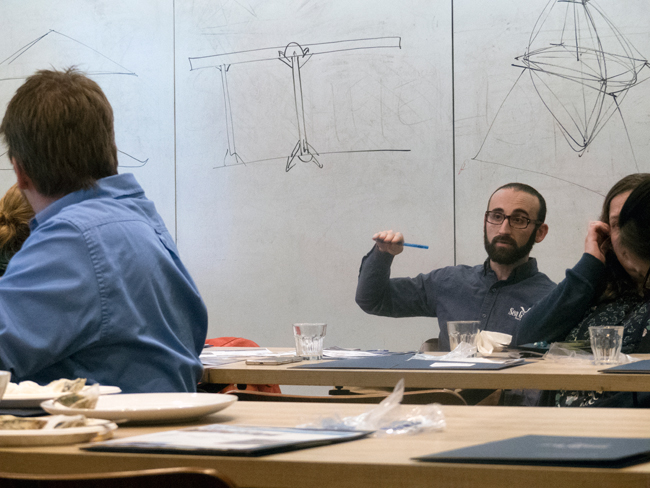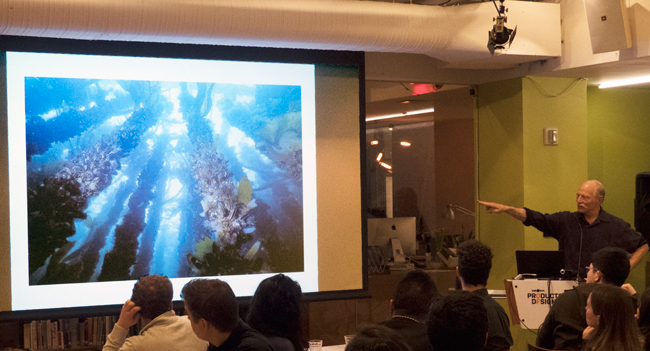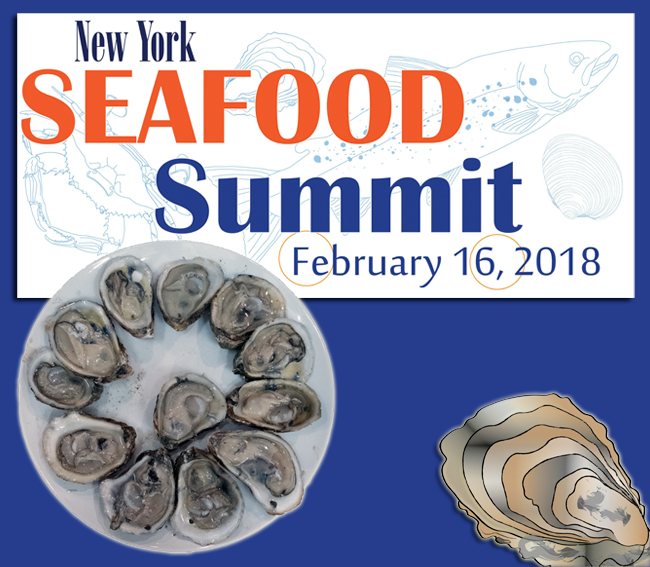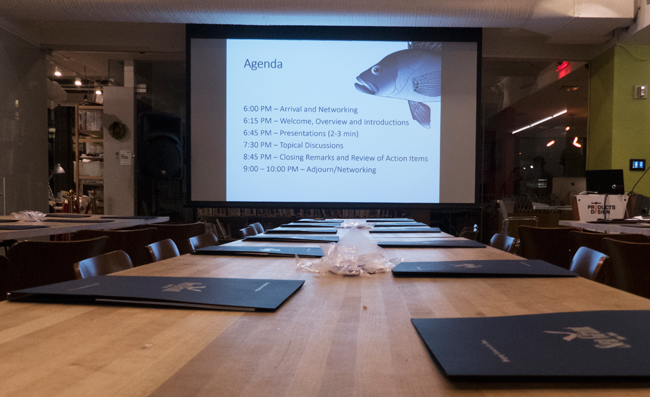
Michael Ciaramella [right] facilitates the discussion on how to effectively streamline fishery regulations. Credit: Ryan Strother for New York Sea Grant
Contacts:
Michael Ciaramella, NYSG’s Seafood Specialist, E: Mc2544@cornell.edu, P: (631) 632-8730
New York, NY, March 16, 2018 – New York Sea Grant (NYSG) hosted its second free, public, New York City-based Seafood Summit in collaboration with industry, academic and other professional seafood stakeholders. All participants of the summit—which was held on Friday, February 16th (6-9 pm) at the MFA Products of Design Program space at the School of Visual Arts (SVA)—were seafood industry stakeholders.
Michael Ciaramella, NYSG’s Seafood Specialist, is currently leading a national visioning effort to identify major national priorities on aquaculture, fisheries and seafood that are also affecting industry stakeholders on a local level. The summit allowed for local stakeholders to provide input and ensure their priorities are reflected in the national visioning efforts. The results of the 2018 summit deliberations also help to effectively focus research and extension programs to meet the needs of the seafood industry in New York.
In 2016, NYSG’s first Seafood Summit provided an opportunity to identify the key issues and concerns of seafood industry stakeholders as a foundation for developing research and extension programs that directly address current needs. Additionally, there were in-depth discussions on sustainability, federal regulations, urban aquaponics and seafood safety & processing. The 2018 summit expanded upon the format of the previous summit and invited participants to give three-minute presentations on programs and/or projects that their organizations are working on.

A summit participant presents “Rebuilding the fishery from tidal marshes to seawalls to the edges of piers.” Credit: Ryan Strother for New York Sea Grant
Fourteen industry stakeholders gave presentations, ranging from “Microalgae and Design” presented a student at the SVA Products of Design School, to “Economic Development Opportunities” presented by a representative of Suffolk County Department of Economic Development & Planning.
Several presentations related specifically to fish farming. A graduate student from the University of Rhode Island spoke about the challenges and opportunities for farming kelp in the northeast market. A spokesperson from a local fish farming organization, presented “R.A.S. and Technology Development in New York,” and a representative from a Brooklyn aquaponics business discussed the possibilities for Urban Aquaponics.
Following the presentations, topical discussions about challenges present in all areas of New York’s seafood industry took place. Areas of discussion included getting fish to market, safety, and processing at sea. Additional discussions focused on lengthy permitting processes, fisheries management processes, and difficulty navigating regulatory differences among agencies.
August Ruckdeschel, the East End Projects Coordinator for Suffolk County Department of Economic Development and Planning, shared his thoughts on the importance of local seafood.
“Amazingly 91% of the seafood we consume is imported and yet 33% of the seafood we catch is exported. While enthusiasm abounds for “local” fruits and vegetables, that enthusiasm has not translated into support for local seafood. We need to change the thinking on this issue. We need to emphasize the sustainability of local seafood. We need to encourage consumers to ask for local fish at their markets, grocery stores, and restaurants and we need to channel the energies within the “foodie” movement to improve the lives of our local fishermen,” said Ruckdeschel.
Peter Haskell, representing Haskell’s Seafood, gave a short presentation on incorporating local seafood into school lunch menus. During the discussion Haskell contributed to conversation on streamlining regulations and collectively investing in the brand of New York Seafood.
“Wild caught fisheries and aquaculture, now and in the future, will not only strengthen if regarded as a cohesive industry, but bolster New York State as a leader in domestic seafood production. Public perception and awareness of NYS seafood will also benefit through education regarding the context of information exchanged at the Summit, which could also be conveyed through promotion. The common sentiment of the well-rounded group attending the NY Seafood Summit was clear; we have an opportunity that is in motion to support, shape, and design an effective structure of a sustainable and economically viable future for NYS seafood while continuing to brand this heritage in the evolving modern world,” said Haskell.

Freshly
shucked oysters served at the Summit. When the attendees were asked if
there was a trademark species for New York State’s seafood market, the
resounding answer was “oysters.” Credit: Michael Ciaramella (artwork); Ryan Strother for New York Sea Grant (shucked oysters image)
Two major action items came out of the collective deliberations. First, NYSG and partners will explore interest in a Seafood Safety at Sea Program. This program would be a voluntary program that promotes on-board practices that could increase the shelf life of seafood while ensuring the safety and quality of locally caught species. Initial efforts, will be aimed at gauging industry interest in the program as stakeholders at all levels—fishermen, wholesalers, and purchasers—would have to value and benefit from the program for successful implementation. An analysis of interest and the potential for adding value to local catch for all stakeholders are important next steps as NYSG explores the possibilities of this program.
The second action item includes compiling guidance documents for navigating regulations. One of the major themes during the stakeholder discussion was the issue of a multitude of regulatory bodies making compliance sometimes confusing and difficult. Further action steps will be taken towards compiling resources to outline the many regulatory steps required of fishermen, farmers, processors and purveyors of all types of seafood. This includes assistance towards navigating the many regulatory steps involved in fish farming.
“We hope to improve the navigability of industry regulations as they impact fish farmers. Whether it’s land-based recirculating, offshore integrated multi-trophic systems, or coastal farming operations, we hope to explore and explain the regulations surrounding that, and the permitting processes required for those operations,” said Ciaramella.
“We plan to work with existing and newly forming farms to identify the process they took or are taking, identify all the agencies one needs to be in touch with, and list the specific permits required to get a farm operational. We ultimately aim to assemble guidance documents that would be helpful for start-up fish farmers trying to navigate compliance and the many regulatory agencies involved in farm permitting, and beyond for those seeking a fully integrated operation.”

The 2018 Seafood Summit included several 2-3-minute presentations from stakeholders throughout the industry. Credit: Ryan Strother for New York Sea Grant
NYSG aims to host Seafood Summits on an annual basis to encourage collaboration, interaction, and to generate awareness about challenges facing the industry. Ultimately, the summits serve to link problems with people and agencies who can help, like New York Sea Grant and other organizations throughout the state. The Seafood summit is a platform to facilitate and encourage collaboration, networking among the industry, and move towards a more sustainable and resilient industry in New York.
More Info: New York Sea Grant
New York Sea Grant (NYSG), a cooperative program of Cornell University
and the State University of New York (SUNY), is one of 33 university-based
programs under the National Oceanic and Atmospheric Administration’s
National Sea Grant College Program.
Since 1971, NYSG has represented a statewide network of integrated
research, education and extension services promoting coastal community
economic vitality, environmental sustainability and citizen awareness
and understanding about the State’s marine and Great Lakes resources.
Through NYSG’s efforts, the combined talents of university scientists
and extension specialists help develop and transfer science-based
information to many coastal user groups—businesses and industries,
federal, state and local government decision-makers and agency managers,
educators, the media and the interested public.
The program maintains Great Lakes offices at Cornell University, SUNY
Buffalo, SUNY Oswego and the Wayne County Cooperative Extension office
in Newark. In the State's marine waters, NYSG has offices at Stony Brook
University in Long Island, Brooklyn College and Cornell Cooperative
Extension in NYC and Kingston in the Hudson Valley.
For updates on Sea Grant activities: www.nyseagrant.org has RSS, Facebook, Twitter, and YouTube links. NYSG produces a monthly e-newsletter, "NOAA Sea Grant's Social Media Review," via its blog, www.nyseagrant.org/blog. Our program also offers a free e-list sign up via www.nyseagrant.org/coastlines for its flagship publication, NY Coastlines/Currents, which is published quarterly.